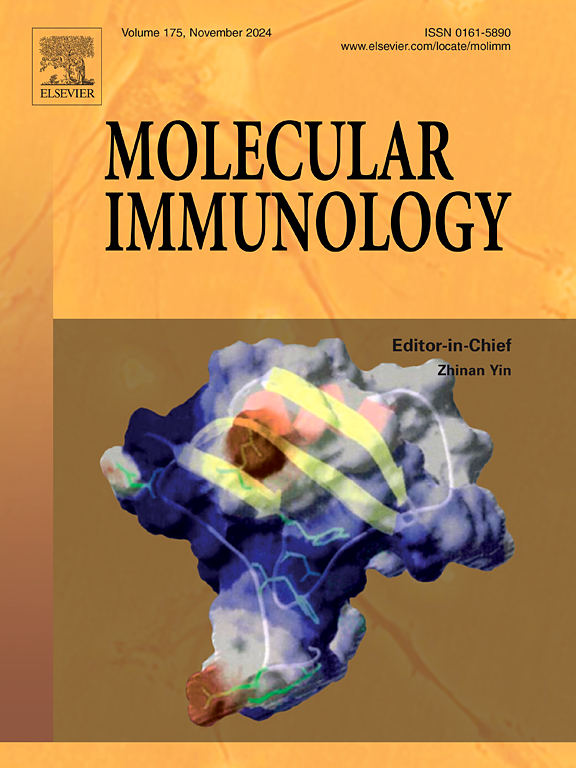Bro p 3, an nsLTP1: The first major allergen identified in Broussonetia papyrifera pollen
IF 3
3区 医学
Q2 BIOCHEMISTRY & MOLECULAR BIOLOGY
引用次数: 0
Abstract
Background
Broussonetia papyrifera pollen is an important cause of allergy worldwide, yet its key allergenic components remain unclear. This study aims to identify and characterize the major allergen of B.papyrifera pollen.
Methods
Patients with allergic rhinitis (AR) symptoms in B.papyrifera pollen season and positive skin prick test (SPT) to B.papyrifera pollen extract were enrolled. Serum sIgE was measured by ImmunoCAP. The pollen crude extract was immunoblotted with patients’ sera. The major allergen was purified and subjected to mass spectrometry analysis. The cDNA of the allergen was cloned from a pollen cDNA library. The antigenicity of recombinant allergen was measured by ELISA. Overlapping peptides spanning the allergen were synthesized. Type 2 T cell epitopes were screened using patients’ PBMC by IL-4 ELISpot. Cross-reactivity of the allergen was evaluated.
Results
B. papyrifera-sIgE was confirmed in 194 of 201 patients by ImmunoCAP. Bro p 3 was identified as major allergen by immunoblot. We purified, cloned the cDNA of, and determined the full-protein sequence of Bro p 3, an nsLTP1 with an average mass of 10264 Da. Recombinant Bro p 3 (rBro p 3) exhibited identical antigenicity as natural Bro p 3, with sensitization rates of 74.53 % and 78.89 %, respectively. Peptides Pep 7–21, Pep 10–24 and Pep 13–27 stimulated IL-4 secretion by T cells from 8, 9 and 8 out of 11 patients. Bro p 3-sIgE sensitization was significantly correlated to elevated sIgE of B. papyrifera, Morus alba, Morus. rubra, and Humulus scandens. It was also associated with the concurrence of conjunctivitis and conjunctivitis plus asthma. No IgE binding was found to the other two B.papyrifera nsLTPs. Bro p 3 inhibited the IgE binding to M. alba and H. scandens pollen extracts.
Conclusions
We demonstrated that Bro p 3 is the major allergen of B. papyrifera pollen and the first allergen from this species with its full sequence determined. The I7-R27 peptides of Bro p 3 represent its immunodominant type 2 T cell epitopes. Bro p 3 sensitization is relevant to clinical phenotypes and the cross-reactivity between M. alba, H. scandens and B.papyrifera pollen.
Bro p3和nsLTP1:在纸草花粉中发现的第一个主要过敏原
纸莎草花粉是世界范围内引起过敏的重要原因,但其主要致敏成分尚不清楚。本研究旨在鉴定和表征纸莎草花粉的主要过敏原。方法选取在纸莎草花粉季节出现变应性鼻炎(AR)症状并对纸莎草花粉提取物皮肤点刺试验(SPT)阳性的患者。免疫cap法测定血清sIgE。用患者血清对花粉粗提物进行免疫印迹。对主要过敏原进行纯化并进行质谱分析。从花粉cDNA文库中克隆出该过敏原的cDNA。ELISA法检测重组过敏原的抗原性。合成了跨越过敏原的重叠肽。2型 T细胞表位采用IL-4 ELISpot筛选。评价变应原的交叉反应性。在201例患者中,有194例经免疫cap检测证实为papyrifera-sIgE。免疫印迹法鉴定Bro p3为主要过敏原。我们纯化、克隆了Bro p3和nsLTP1的cDNA,并确定了其全蛋白序列,平均质量为10264 Da。重组Bro p3 (rBro p3)具有与天然Bro p3相同的抗原性,致敏率分别为74.53 %和78.89 %。肽Pep 7-21、Pep 10-24和Pep 13-27分别刺激8、9和8例患者的T细胞分泌IL-4。Bro p3 -sIgE致敏与纸莎草、白桑、桑的sIgE升高显著相关。红草和葎草。同时与结膜炎和结膜炎合并哮喘有关。另外两种纸莎草杆菌nsltp未发现IgE结合。Bro p3抑制了白僵菌和scandens花粉提取物的IgE结合。结论Bro p3是纸草花粉的主要变应原,也是第一个确定其全序列的变应原。Bro p3的I7-R27肽代表其免疫优势的2型T细胞表位。Bro p3致敏性与临床表型和白僵菌、scandens和纸叶僵菌花粉的交叉反应性有关。
本文章由计算机程序翻译,如有差异,请以英文原文为准。
求助全文
约1分钟内获得全文
求助全文
来源期刊

Molecular immunology
医学-免疫学
CiteScore
6.90
自引率
2.80%
发文量
324
审稿时长
50 days
期刊介绍:
Molecular Immunology publishes original articles, reviews and commentaries on all areas of immunology, with a particular focus on description of cellular, biochemical or genetic mechanisms underlying immunological phenomena. Studies on all model organisms, from invertebrates to humans, are suitable. Examples include, but are not restricted to:
Infection, autoimmunity, transplantation, immunodeficiencies, inflammation and tumor immunology
Mechanisms of induction, regulation and termination of innate and adaptive immunity
Intercellular communication, cooperation and regulation
Intracellular mechanisms of immunity (endocytosis, protein trafficking, pathogen recognition, antigen presentation, etc)
Mechanisms of action of the cells and molecules of the immune system
Structural analysis
Development of the immune system
Comparative immunology and evolution of the immune system
"Omics" studies and bioinformatics
Vaccines, biotechnology and therapeutic manipulation of the immune system (therapeutic antibodies, cytokines, cellular therapies, etc)
Technical developments.
 求助内容:
求助内容: 应助结果提醒方式:
应助结果提醒方式:


